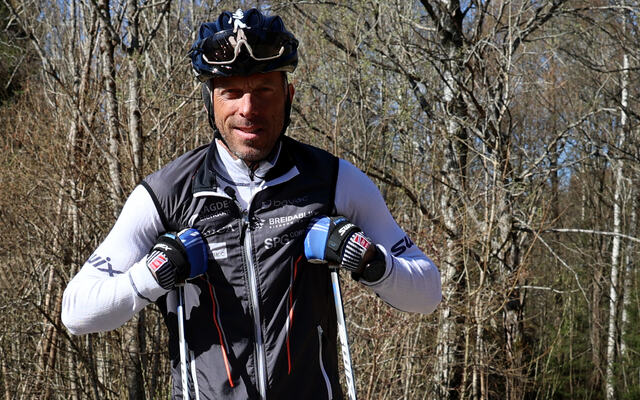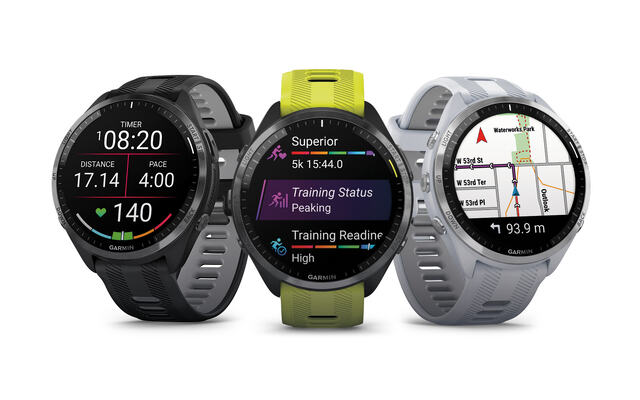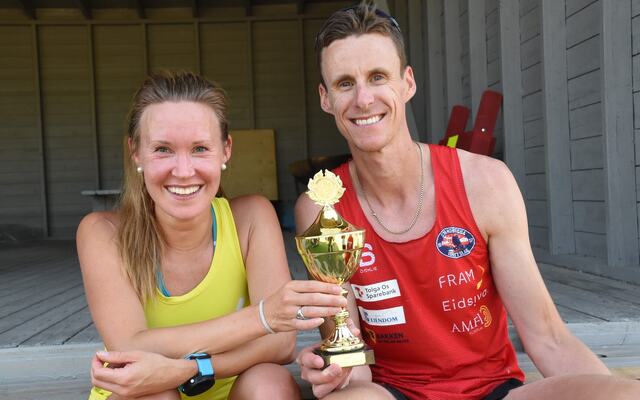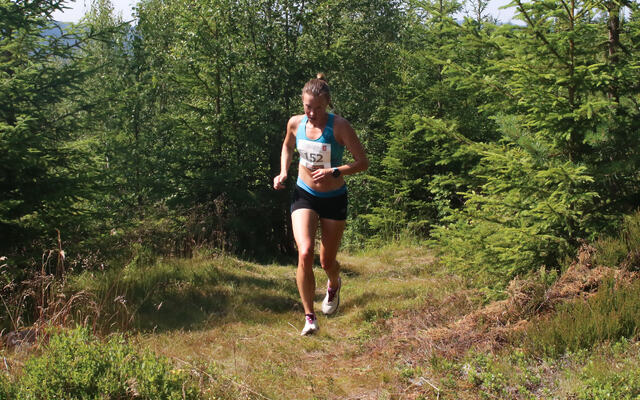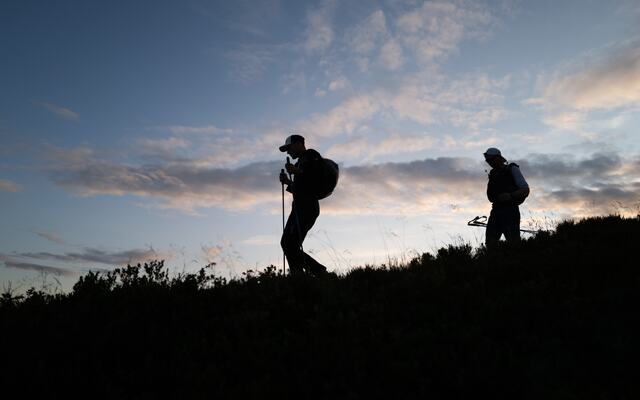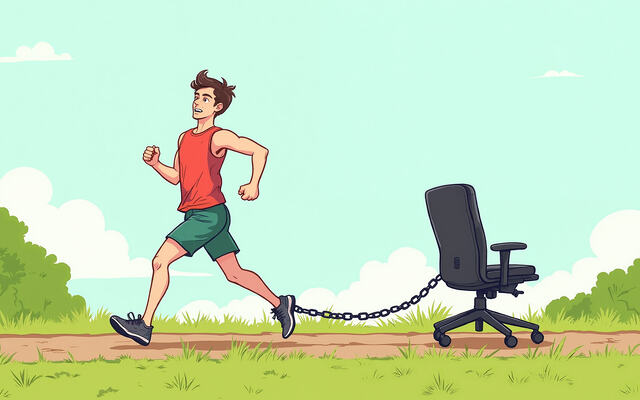Laks best for kondisjonsidrett
Kilde: artikkelen er hentet fra Runners World
Liz's Top Ten
by Liz Applegate, Ph.D.
Look no further to see if you are getting all the nutrients you need
At the end of the day, who really knows if they're getting all the nutrients they need? Especially when you consider that you require over 50 individual nutrients for maintaining good health.
Let's face it, you'd go crazy trying to keep track of all 50, so I'm going to simplify things a bit. I'm going to list the 10 most important ones. The way I figure it, if you eat foods that contain these 10, you'll likely be getting the other 40-some nutrients at the same time. Here, in alphabetical order, are the top 10 nutrients for runners.
Calcium
Calcium. Always has been and always will be the mineral for bone health. And bone health is not just a "woman's" thing. Sure, osteoporosis is a bigger concern for women, but in both men and women, bones lose calcium as they age. And you speedsters beware: some studies have shown that elite-level cyclists and runners may suffer bone-mineral loss because of their intense training.
To keep bones healthy, get your calcium, and plenty of it. Make dairy products-low-fat milk, yogurt, cheese, cottage cheese-a regular part of your daily menu. Even if you're lactose intolerant, you may be able to consume a cup or more of milk or yogurt a day if you spread out your intake. Also, look for calcium-fortified soy milk and orange juice, plus tofu, canned salmon, broccoli and tortillas made with lime.
Carbohydrates
No surprise here, as you need energizing carbohydrates for replenishing spent muscle-glycogen stores. Plain and simple, if you're not well stocked with carbohydrates, you're not going to run well. (Unfortunately, I see this happening a lot with busy runners who find it hard to stay consistent in their eating.)
Aim for 400 grams (1,600 calories) as a daily goal-and more if you do high mileage or if you eat considerably more than 2,500 total calories a day. To get a daily average, keep track of your carbohydrate servings for two or three days in succession. You'll know you're on the right track if you come close to the following numbers each day: 10 servings of grains (one slice of bread or 1/2-cup of cereal or pasta = one serving); seven servings of fruit (one medium-size piece or 1/2-cup of juice = one serving); four servings of vegetables (1 cup raw or 1/2-cup cooked = one serving); and two to three servings of dairy (1 cup = one serving).
Essential fats
That's right, some fat is essential. Also, many of you aren't getting enough of a certain group of fats called omega-3s, and research suggests this deficiency may contribute to the development of heart disease and arthritis. Omega-3s are found primarily in fish, especially "fatty" fish such as sardines and salmon. In the human body, these fats transform into hormone-like substances that help regulate blood clotting, menstruation and several other processes.
So try to make fish a regular part of your diet by aiming for two to three servings a week. For salad dressings, you might try using flaxseed oil, which is rich in omega-3s, instead of the more standard vegetable oils. One caveat: Omega-3s are easily destroyed by high heat, so don't use flaxseed oil for cooking.
Folate (Folic acid)
Researchers have been touting the importance of this B vitamin for years. And no wonder. Women who don't get enough folate before and during pregnancy increase their risk of having babies with birth defects, and men who skimp on folate increase their risk of heart disease. Among women and men, folate keeps blood cells healthy and fights off a severe form of anemia.
While folate is relatively scarce in foods, you'll have an easier time meeting your folate needs as of January 1998. At that point, in an effort to help more of us meet the RDA of 400 mg, the U.S. Food and Drug Administration will begin its folate-fortification program, in which all enriched-grain products (breads, cereals, pastas) will be folate-fortified. Meanwhile, good folate sources include leafy green vegetables, lentils, fortified cereals and citrus fruits.
Iron
You have to have adequate iron in your blood to get oxygen to your working muscles. What happens if you don't get enough? You'll suffer from extreme fatigue, lagging race performances and, oftentimes, an intolerance to cold. Since you may be losing some iron via sweat and urine, and because running itself can hamper your ability to absorb the mineral, you need to be careful about your intake.
To be sure you're hitting your RDA (10 mg for men; 15 mg for women 50 and under; 10 mg for women over 50), try to get iron from a variety of sources. Once again (as with protein and zinc), meat is probably the best source because it contains heme iron, which is the most readily absorbable form of iron. Other good sources are iron-fortified cereals, lentils and broccoli. Eat a vitamin C-rich food with your iron source, as vitamin C significantly improves iron absorption. And keep away from supplements that contain more than 15 mg of iron; too much iron can hamper zinc absorption.
Phytochemicals
Technically, these little disease-fighting dynamos aren't considered nutrients. However, they're so essential I didn't want to leave them off the list. Found in fruits, vegetables and grains, there are some 500 different phytochemicals that help protect you against cancer, heart disease, arthritis, even wrinkles. Example 1: The polyphenols found in grapes and tea blunt the effects of "bad" LDL cholesterol. (Scientists believe the antioxidant power of these natural wonders may be 20 times that of vitamin C.) Example 2: The isoflavones in soybeans fight off osteoporosis, breast and prostate cancers, and menopausal symptoms such as night sweats and hot flashes.
The best way to fill up on phytochemicals is to eat a variety of fruits, vegetables and grains. And variety is key, as no one food contains all the phytochemicals. So don't get into a rut of always eating, say, broccoli as your vegetable and an apple as your fruit. Try a new fruit or vegetable each week-for variety and better health.
Protein
This is the stuff we're made of-literally. Every part of your body contains protein, from the muscles, blood and immune cells to tendons, ligaments, skin and hair. Sedentary people need 50 to 70 grams of protein a day to keep them going. Runners need more-a good 25 to 50 percent more-to take care of muscle repair and increased energy requirements.
Here's the dilemma with protein: the very people who need more of it (i.e., runners) are often the ones who don't get enough. The reason, basically, is because runners tend to eat less meat than sedentary people, and meat is one of the best sources of protein. Skimping on protein can cause fatigue and slow recovery from injuries and infections, so be sure you're getting enough from high-quality sources such as lean meat, soybeans (in the form of tofu, soy milk or soy protein), fish and low-fat dairy products. Each day, try to include 5 to 6 ounces of lean meat or two to three servings of soy products, plus two to three servings of low-fat or nonfat dairy products and several servings of grains.
Vitamin C
This antioxidant helps protect your body from oxidative damage caused by exercise and other stresses such as air pollution and secondhand smoke. Vitamin C is also critical for maintaining a strong immune system, which can be taxed by high mileage. A study at the University of Cape Town Medical School in South Africa had runners taking 600 mg of vitamin C a day (10 times the RDA) for three weeks prior to an ultramarathon. After the race, their incidence of upper respiratory tract infections was significantly lower than those who had been taking a placebo. You can get plenty of vitamin C from foods. For example, an orange and a kiwifruit each supply more than 130 percent of the RDA. Many other fruits and vegetables (strawberries, green peppers and tomatoes, to name three) contain over 50 percent of the RDA per serving.
Vitamin E
Many researchers believe this powerful antioxidant protects us from age-related ailments such as heart disease and cancer. As with vitamin C, studies also show that vitamin E supplementation-often at the level of about 400 IU a day-may help protect you from the oxidative damage caused by endurance exercise. This free-radical-induced damage is what causes muscle stiffness and soreness.
I'd love to say you can get all the E you need via foods, but that's very difficult to do. After all, 400 IU is over 1,000 percent of the RDA. Therefore, it could be time to start supplementing with vitamin E. If you decide to do so, 400 IU should do it-no more. For those who'd rather not take a supplement, the best food sources are almonds and wheat germ, with an ounce of the latter providing 50 percent of your RDA. Fortified breakfast cereals are also good choices, as they normally contain about 25 percent of the RDA.
Zinc
Zinc keeps your immune system healthy, it makes wound healing and injury recovery possible, and it's vital for male sexual functioning. Despite its importance, studies have shown that runners often don't consume their RDA for this mineral (15 mg for men; 12 mg for women). Since you also sweat out small amounts of it each time you run, you can quickly become deficient in zinc. The tell-tale sign of a deficiency? More frequent colds. You may also be more susceptible to infections and bronchitis.
As with iron and protein, the zinc found in beef, poultry, pork, lamb and seafood is well absorbed by the body. Getting enough zinc can be tricky if you don't eat meat. Vegetarians should look to fortified cereals for zinc, as they come with anywhere from 25 to 100 percent of the RDA per serving. Beans, black-eyed peas, whole-grain breads and wheat germ are also good sources.
Liz's Top Ten
by Liz Applegate, Ph.D.
Look no further to see if you are getting all the nutrients you need
At the end of the day, who really knows if they're getting all the nutrients they need? Especially when you consider that you require over 50 individual nutrients for maintaining good health.
Let's face it, you'd go crazy trying to keep track of all 50, so I'm going to simplify things a bit. I'm going to list the 10 most important ones. The way I figure it, if you eat foods that contain these 10, you'll likely be getting the other 40-some nutrients at the same time. Here, in alphabetical order, are the top 10 nutrients for runners.
Calcium
Calcium. Always has been and always will be the mineral for bone health. And bone health is not just a "woman's" thing. Sure, osteoporosis is a bigger concern for women, but in both men and women, bones lose calcium as they age. And you speedsters beware: some studies have shown that elite-level cyclists and runners may suffer bone-mineral loss because of their intense training.
To keep bones healthy, get your calcium, and plenty of it. Make dairy products-low-fat milk, yogurt, cheese, cottage cheese-a regular part of your daily menu. Even if you're lactose intolerant, you may be able to consume a cup or more of milk or yogurt a day if you spread out your intake. Also, look for calcium-fortified soy milk and orange juice, plus tofu, canned salmon, broccoli and tortillas made with lime.
Carbohydrates
No surprise here, as you need energizing carbohydrates for replenishing spent muscle-glycogen stores. Plain and simple, if you're not well stocked with carbohydrates, you're not going to run well. (Unfortunately, I see this happening a lot with busy runners who find it hard to stay consistent in their eating.)
Aim for 400 grams (1,600 calories) as a daily goal-and more if you do high mileage or if you eat considerably more than 2,500 total calories a day. To get a daily average, keep track of your carbohydrate servings for two or three days in succession. You'll know you're on the right track if you come close to the following numbers each day: 10 servings of grains (one slice of bread or 1/2-cup of cereal or pasta = one serving); seven servings of fruit (one medium-size piece or 1/2-cup of juice = one serving); four servings of vegetables (1 cup raw or 1/2-cup cooked = one serving); and two to three servings of dairy (1 cup = one serving).
Essential fats
That's right, some fat is essential. Also, many of you aren't getting enough of a certain group of fats called omega-3s, and research suggests this deficiency may contribute to the development of heart disease and arthritis. Omega-3s are found primarily in fish, especially "fatty" fish such as sardines and salmon. In the human body, these fats transform into hormone-like substances that help regulate blood clotting, menstruation and several other processes.
So try to make fish a regular part of your diet by aiming for two to three servings a week. For salad dressings, you might try using flaxseed oil, which is rich in omega-3s, instead of the more standard vegetable oils. One caveat: Omega-3s are easily destroyed by high heat, so don't use flaxseed oil for cooking.
Folate (Folic acid)
Researchers have been touting the importance of this B vitamin for years. And no wonder. Women who don't get enough folate before and during pregnancy increase their risk of having babies with birth defects, and men who skimp on folate increase their risk of heart disease. Among women and men, folate keeps blood cells healthy and fights off a severe form of anemia.
While folate is relatively scarce in foods, you'll have an easier time meeting your folate needs as of January 1998. At that point, in an effort to help more of us meet the RDA of 400 mg, the U.S. Food and Drug Administration will begin its folate-fortification program, in which all enriched-grain products (breads, cereals, pastas) will be folate-fortified. Meanwhile, good folate sources include leafy green vegetables, lentils, fortified cereals and citrus fruits.
Iron
You have to have adequate iron in your blood to get oxygen to your working muscles. What happens if you don't get enough? You'll suffer from extreme fatigue, lagging race performances and, oftentimes, an intolerance to cold. Since you may be losing some iron via sweat and urine, and because running itself can hamper your ability to absorb the mineral, you need to be careful about your intake.
To be sure you're hitting your RDA (10 mg for men; 15 mg for women 50 and under; 10 mg for women over 50), try to get iron from a variety of sources. Once again (as with protein and zinc), meat is probably the best source because it contains heme iron, which is the most readily absorbable form of iron. Other good sources are iron-fortified cereals, lentils and broccoli. Eat a vitamin C-rich food with your iron source, as vitamin C significantly improves iron absorption. And keep away from supplements that contain more than 15 mg of iron; too much iron can hamper zinc absorption.
Phytochemicals
Technically, these little disease-fighting dynamos aren't considered nutrients. However, they're so essential I didn't want to leave them off the list. Found in fruits, vegetables and grains, there are some 500 different phytochemicals that help protect you against cancer, heart disease, arthritis, even wrinkles. Example 1: The polyphenols found in grapes and tea blunt the effects of "bad" LDL cholesterol. (Scientists believe the antioxidant power of these natural wonders may be 20 times that of vitamin C.) Example 2: The isoflavones in soybeans fight off osteoporosis, breast and prostate cancers, and menopausal symptoms such as night sweats and hot flashes.
The best way to fill up on phytochemicals is to eat a variety of fruits, vegetables and grains. And variety is key, as no one food contains all the phytochemicals. So don't get into a rut of always eating, say, broccoli as your vegetable and an apple as your fruit. Try a new fruit or vegetable each week-for variety and better health.
Protein
This is the stuff we're made of-literally. Every part of your body contains protein, from the muscles, blood and immune cells to tendons, ligaments, skin and hair. Sedentary people need 50 to 70 grams of protein a day to keep them going. Runners need more-a good 25 to 50 percent more-to take care of muscle repair and increased energy requirements.
Here's the dilemma with protein: the very people who need more of it (i.e., runners) are often the ones who don't get enough. The reason, basically, is because runners tend to eat less meat than sedentary people, and meat is one of the best sources of protein. Skimping on protein can cause fatigue and slow recovery from injuries and infections, so be sure you're getting enough from high-quality sources such as lean meat, soybeans (in the form of tofu, soy milk or soy protein), fish and low-fat dairy products. Each day, try to include 5 to 6 ounces of lean meat or two to three servings of soy products, plus two to three servings of low-fat or nonfat dairy products and several servings of grains.
Vitamin C
This antioxidant helps protect your body from oxidative damage caused by exercise and other stresses such as air pollution and secondhand smoke. Vitamin C is also critical for maintaining a strong immune system, which can be taxed by high mileage. A study at the University of Cape Town Medical School in South Africa had runners taking 600 mg of vitamin C a day (10 times the RDA) for three weeks prior to an ultramarathon. After the race, their incidence of upper respiratory tract infections was significantly lower than those who had been taking a placebo. You can get plenty of vitamin C from foods. For example, an orange and a kiwifruit each supply more than 130 percent of the RDA. Many other fruits and vegetables (strawberries, green peppers and tomatoes, to name three) contain over 50 percent of the RDA per serving.
Vitamin E
Many researchers believe this powerful antioxidant protects us from age-related ailments such as heart disease and cancer. As with vitamin C, studies also show that vitamin E supplementation-often at the level of about 400 IU a day-may help protect you from the oxidative damage caused by endurance exercise. This free-radical-induced damage is what causes muscle stiffness and soreness.
I'd love to say you can get all the E you need via foods, but that's very difficult to do. After all, 400 IU is over 1,000 percent of the RDA. Therefore, it could be time to start supplementing with vitamin E. If you decide to do so, 400 IU should do it-no more. For those who'd rather not take a supplement, the best food sources are almonds and wheat germ, with an ounce of the latter providing 50 percent of your RDA. Fortified breakfast cereals are also good choices, as they normally contain about 25 percent of the RDA.
Zinc
Zinc keeps your immune system healthy, it makes wound healing and injury recovery possible, and it's vital for male sexual functioning. Despite its importance, studies have shown that runners often don't consume their RDA for this mineral (15 mg for men; 12 mg for women). Since you also sweat out small amounts of it each time you run, you can quickly become deficient in zinc. The tell-tale sign of a deficiency? More frequent colds. You may also be more susceptible to infections and bronchitis.
As with iron and protein, the zinc found in beef, poultry, pork, lamb and seafood is well absorbed by the body. Getting enough zinc can be tricky if you don't eat meat. Vegetarians should look to fortified cereals for zinc, as they come with anywhere from 25 to 100 percent of the RDA per serving. Beans, black-eyed peas, whole-grain breads and wheat germ are also good sources.
Siste medlemssaker
Annonse

